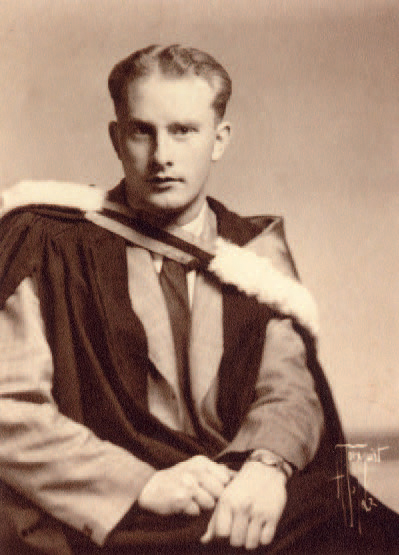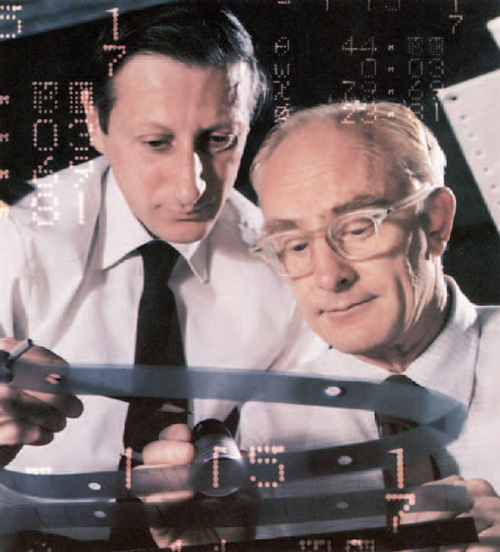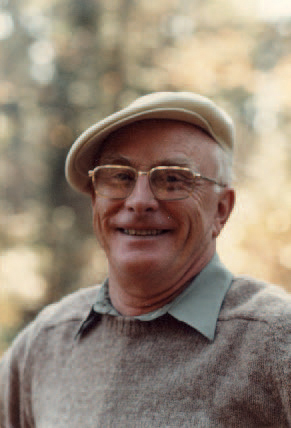- History Home
- People, Leadership & Service
- A Legacy of Excellence
- History & Impact
- Meetings Through the Years
- Resources
Crystallography in CanadaLarry Calvert (1924-1993): Metals, accuracy, powder method
Principal Research Officer, ICPET, National Research Council of Canada, Ottawa, Ontario Reprinted from CNCC Newsletter No 1 (Canadian National Committee for Crystallography) September 2009
Lauriston (Larry) Derwent Calvert (Ahmed & Le Page, 1993; Wallace & Mueller, 1993) was the son of Fred Clifford Calvert (1900-1974), a New Zealand Mining Engineer who worked mostly for tin dredging in Malaysia and for gold exploration or mining at many places in the south hemisphere, registering his son at boarding schools where possible. Larry's pre-university education was accordingly garnered at a number of different schools, most of them in New Zealand, but it also included the Suva Boys Grammar School where he befriended sons of Fijian chiefs. At school recess time, he found employment in ordinary manual jobs, one of them cutting meat at a sheep meat-packing factory in New Zealand. He graduated in Philosophy from the University of New Zealand in Auckland. Awarded a M.Sc. and then a Ph.D. in Chemistry in 1952, with Dame Kathleen Lonsdale as external examiner, Dr. Larry Calvert (Fig.1) became the first New-Zealander crystallographer. On that year, he came to the Division of Physics of the National Research Council of Canada (NRC) as a Research Associate with Dr Barnes (Ahmed et al., 1981). Two years later, as a staff Assistant Research Officer, he started an X-ray lab at NRC's then new Division of Applied Chemistry, from which he retired in 1985 as a Principal Research Officer (Fig. 2). Larry had two children, Alistair and Margaret, with his first wife Marjorie (d. 1980). He re-married in 1982 with Barbara (now Campbell). They retired at Lakes Entrance in the state of Victoria, Australia where he died in 1993, not very far from Tasmania, where he was born (Fig. 3).
Larry was a man of substance and few words, with gentlemanly education and manners. He had a very strong sense of ethics and duty. A keen and sharp observer of his surroundings, he was not a person to be fooled by fast speech or pointless authority. Always friendly in his attitude, he was very cautious and concise in his written or spoken words, often carefully selected tongue-in-cheek words, to the extent that his wise replies and sound advice might at times have to be decrypted. He would never engage in a protracted argument or volunteer unsolicited advice or harsh comments. For example, if asked privately about an unconvincing presentation, he would use words like "jazzy" to indicate a great presentation effort combined with modest substance, or "jazzed-up" when the speaker had basically re-discovered the wheel. Results already presented several times before might be qualified with "re-hash". "Gum-flapping" would similarly convey his general evaluation of an unnecessary meeting without wasting words. If asked publicly, he would rather retreat behind a pretended "loss of hearing due to old age" than volunteer negative comments.
As a person, Larry was characterized by a combination of a strong literary background, a curiosity for anything culturally different, a love for the south hemisphere where he had grown up, and a sound judgment based on personal experience, on timeless wisdom and on biographies of which he was a keen reader. His approach to science and to life in general was always firmly based on facts or on time-proven observations, never far from verifiable facts. Larry was very knowledgeable about trees, plants, birds etc. of the Ottawa area, but his concept of a common tree remained a eucalyptus or a gum tree all along. Larry knew every illustration and every description in The Birds of Brewery Creek (Macdonald, 1947), but his concept of a bird was a kookaburra, a kiwi, or a parakeet. From his secondary school years in Fiji and New Zealand, he had acquired and retained all along a great interest and deep respect for aboriginal cultures of the South Pacific. Larry also relished in the company of any person from a different culture or a different background and loved to converse with them, mostly listening while sharing a brew or two, or introducing them to Koonunga Hill wines or Malay curry dishes. To settle an argument, or to show what the right direction was without wasting words, he would easily quote a Latin proverb or maxim with no ostentation: The point that the item being discussed and its time-proven solution were nothing new was instantly made. This came to him very naturally because his undergraduate education had been so strong in languages, literature and philosophy. Although he never mentioned it, Larry was a very regular blood donor as he left behind a Red-Cross pin awarded to people who had given blood more than fifty times, still on its cardboard support bearing his name.
Scientifically, Larry focused on basics about few key topics, most of which are still under development today. He maintained for example up-to-date files about precision and accuracy in diffraction-intensity and diffraction-angle measurement, about absorption and extinction corrections, about incident-beam polarization, about correction for polarization by the sample, about twinning, about standard materials and similar topics. While also practicing single- crystal diffraction, Larry has been a staunch and enthusiastic proponent and practitioner of the powder method. The Rietveld least-squares full profile analysis (Rietveld, 1967) was for him one of the great inventions of the XXth century that would finally give justice to the then obsolescent powder-diffraction methods. He was eventually shown right and vindicated. He triumphed when the lecture room allotted to powder methods at the XIIth IUCr Meeting in Ottawa in 1981 was chock-full with standing attendance, many from industry, marking a turnpoint in the renaissance of powder methods. Over the years, he has accumulated a collection of thousands of photographic powder-diffraction reference patterns of intermetallic materials that is still kept at NRC. He has contributed nearly 1,300 new experimental powder patterns to the JCPDS, and then ICDD Powder Diffraction File, most of them for intermetallic materials.
Larry was an extremely careful, even meticulous experimenter, always using internal standards for example, developing his own equipment with specially designed incident-beam or diffracted-beam monochromators, focusing geometry, evacuated diffraction chambers or multi-sample holders. He spent a lot of time fine-tuning all this, never fully satisfied with results. He designed and built an evacuated small-angle scattering camera for fiber- diffraction studies with a remarkable collimation system that is still in use at NRC.
Dr. Calvert was not a big supporter of the then-prevailing "publish-or-perish" approach to scientific research administration. He was instead patient and very thorough in everything he undertook, with meticulous attention to detail. In spite of this, he is author or co-author of 87 quality publications, spanning from 1954 to 1992, many of them on intermetallic materials, in particular rare-earth pnictides or CaNi5-type hydrogen-storage alloys (Calvert et al., 1985), way ahead of the current frenzy. His most frequent or noted co-authors have been Bryan Taylor (Fig. 2), John Murray, Don Heyding, Sandy Mathieson, Yu Wang, Eric Gabe, Allen Larson etc. His models for significant research were people like E.H. Swanson from NBS, now NIST and A.McL. Mathieson from CSIRO. Larry remained active in his retirement, as he co-edited with Pierre Villars the huge volumes of Pearson's Handbook of Crystallographic Data for Intermetallic Phases (1985, 1991) and wrote several articles, the last one in 1992.
Larry has been Co-Editor of fourteen Structure Reports volumes from 1959 to 1981. The goal of those Reports was to collate succinct edited numerical primary data and graphic results for all crystal structures printed world-wide for that year, and that would nevertheless be so thorough that going back to the original paper would be unnecessary. Patiently cross-checking cell data, atom coordinates, Wyckoff positions as well as distances and angles was a monster job, often requiring querying authors internationally by steampost about typos in cell data or coordinates. A large majority of authors answered his polite and down-to-earth requests. As a consequence, his Structure Reports sections are actually more valuable than the original papers because they are free from typos. In other words, Larry's Structure Reports were the paper equivalent of edited crystal-structure database entries in those pre-internet days where even in-lab computers were a rarity.
Although not truly fluent in computer programming, Larry has been all along an enthusiastic supporter of quality crystallographic software, adding Eric Gabe and later myself, and then John Rodgers to the staff of the Chemistry Division's X-ray Diffraction lab. Larry was frequently inviting Allen Larson from Los Alamos for extended visits. This led to the automation of structure cross-checks for Structure Reports and to a pioneer version of crystal-structure databases, as a by-product of the automation of crystallographic data collection and its efficient and correct processing. The effort also allowed the creation of the NRCCAD and NRCVAX packages at the Chemistry Division in Ottawa, which are still in use today.
Larry assembled the Metals Data File (MDF) from the pre- 1969 data that Don Cromer from LASL in Los Alamos, Bill Pearson from the University of Waterloo and himself had gathered in different formats. He integrated them and carried on with the whole post-1969 task until 1984. The initial programming by Allen Larson from LASL included such key routines as SPGP, a very compact routine to generate the general position of any space group from its Hermann-Mauguin short symbol, in standard orientation or not. This MDF software package was then much expanded by Eric Gabe, Yu Wang and Florence Lee in collaboration with Allen Larson. Data collection, extraction and input was performed by John Byron, while Larry edited it. In 1984, the MDF contained 5,600 entries, representing essentially all intermetallic crystal structures solved from 1913 to 1984. The MDF later became NRC's CRYSTMET relational database, developed with the help of John Rodgers, Pierre Villars and Gordon Wood. In those pre- internet days, where email was the fastest way to communicate, CRYSTMET was automated to answer email queries. Nowadays, CRYSTMET is a Windows package that runs on PCs and contains over 128,000 edited entries. It is up-to-date for intermetallic compounds and has been expanded to include inorganic entries as well. Not much of this would exist today without Larry's vision and relentless pioneering efforts.
Larry has intensely participated in professional activities. An active member of the ACA, he has presided its Nomination Committee and its Fankuchen Award Committee. He has been Local Chair of the Ottawa ACA meeting in 1970 and a member of the Committee on Standards for the Publication of Powder Patterns. Internationally, he was a member of the Editorial Board of Zeitschrift für Kristallographie. At the IUCr level, he participated in the CNC/IUCr from 1970 to 1976, the last three years as its secretary. In addition to his involvement with Structure Reports, Larry was deeply involved with ICDD. He went on attending their semi-annual meetings until 1993, as Chair of the Metals and Alloys Subcommittee (Wallace & Mueller, 1993). Larry was Local Chair of the XIIth IUCr Congress and General Assembly at Carleton University in Ottawa in 1981, with Farid Ahmed as Program Chair. This was before the times when Congress Centers professionally handling all daily activities around the meeting sprouted in most big cities. This was also before Internet and even before FAX or email became widespread internationally. Most registration items accordingly had to be handled by steampost, and all accounting was on paper. All accompanying members' activities had to be arranged months ahead of time, with a deposit. With seed money from the IUCr and from NRC, and the support of Ken Charbonneau from NRC's Congress Office, everything went smoothly. The larger-than-anticipated attendance at the Carleton University site even left a very sizeable surplus in the hands of the CNC/IUCr after returning the seed money.
With the CNC/IUCr, Larry went through the patient paperwork of creating a tax-exempt charity CNC/IUCr Trust Fund with the sole function of awarding Student Travel Bursaries to IUCr meetings from the tax-free interest gathered by the IUCr XII surplus money in the fund. This fund has since helped to send students in Canada attend nearly all IUCr Meetings, usually one, two or sometimes three each time. This fund was renamed the "L.D. Calvert CNC/IUCr Trust Fund" by a unanimous vote of the CNC/IUCr shortly before Larry died in 1993, in time for Larry to be personally informed about it.
Retrospectively, Larry Calvert has been a man with vision, attracted by the steady and often thankless effort of huge tasks with lasting value, and preaching only by example. A most careful experimenter with encyclopedic knowledge of metals and alloys, he will probably be remembered scientifically mostly for rare-earth pnictides, for his pioneering crystal-structure database efforts, for his staunch involvement in ICDD and for his role as Local Chair of the XIIth IUCr Meeting in Ottawa in 1981. A new pnictide mineral species, Cu5Ge0.5S4, has recently been very appropriately named calvertite (Jambor et al., 2007) after Larry. He left a scientific heritage of lasting value that has helped put modern crystallography on its tracks. At the personal level, he is remembered as a reserved man with a sharp sense of observation, gentlemanly education and manners, caring for others without ostentation. He will undoubtedly go on doing that for many years to come through the L.D. Calvert CNC/IUCr Student Travel Bursaries he created and funded.
References Ahmed, F.R., Calvert, L.D., Hanson, A.W. & Przybilska, M. (1981). Acta Crystallogr. A37, 269-269. Ahmed, F.R. & Le Page, Y. (1993). ACA bulletin, June 1993 p.9. Calvert, L.D., Powell, B.M., Murray, J.J. & Le Page, Y. (1985). J. Solid St. Chem. 60, 62-67. Jambor, J.L., Roberts, A.C., Groat, L.A., Stanley, C.J., Criddle, A.J. & Feinglos, M.N. (2007). Canadian Mineralogist 45, 1519-1523. Macdonald, M. (1947). The Birds of Brewery Creek. Oxford University Press, Toronto. Rietveld,H.M. (1967). Acta Crystallogr. 22, 151-152. Villars, P. & Calvert L.D. (1985). Pearson's Handbook of Crystallographic Data for Intermetallic Phases. ASM International, Materials Park, Ohio. (First edn, 1985, second edn, 1991)
Wallace, P.L. & Mueller, M.H. (1993). Powder Diffraction 8, 73-73. |



